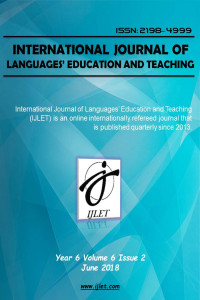Öz
Bu çalışma yabancı dil olarak Türkçe öğretiminde yapılacak çalışmalara ışık tutmak ve alana katkı sağlamak amacıyla hazırlanmıştır. Bu çalışmada Yunus Emre Enstitüsünün 2015 yılında yayınladığı Yedi İklim Serisi A1, A2, B1, B2, C1 ve C2 ders kitaplarında yer alan metinlerdeki kültür unsurları incelenmiştir. Bu çalışmada Yunus Emre Enstitüsünün hazırlamış olduğu Yedi İklim serisi ders kitaplarında yer alan metinlerdeki kültürel unsurlar; konu alanı, görsellik ve metin türü açısından incelenmiştir. Konu alanı, görsellik ve metin türü kriterleri Haley ve Austin (2004: 93), Byram ve Risager ( 1999: s. 93), Guariento ve Morley ( 2001: s. 347) ve Avrupa Dilleri Ortak Çerçeve Metninde (ADOÇ) belirtilen kültürel unsurların öğretimi dikkate alınarak incelenmiştir. Ders kitaplarındaki kültürel unsurların, hedef kültür dediğimiz Türk kültürünü ne orada yansıttığı, evrensel kültürden de unsurların olup olmadığı belirlenmiştir. Ayrıca konu alanı incelenirken, konuların temel yaşam deneyim alanından seçilip seçilmediği, metinde işlenen konu adının ne olduğu ve metinlerin hedef kültür olan Türk kültürüne mi ait yoksa evrensel kültüre mi ait olduğu incelenmiştir. Metinlerdeki görsellerin ise hedef kültüre mi yoksa evrensel kültüre mi ait olduğuna ve görselin fotoğraf mı, resim mi yoksa karikatür mü olduğuna bakılarak incelenmiştir. Metin türü açısından ise, metinlerin özgün bir metin mi, yoksa ders kitabı için yazılmış kurma bir metin mi olduğuna özgün metin ise özgün metnin türünün ne olduğu detaylı olarak incelenmiştir.
Anahtar Kelimeler
Türkçenin Yabancı Dil Olarak Öğretimi Yedi İklim Türkçe Serisi Ders Kitapları Kültür Aktarımı Türk Kültürü
Kaynakça
- Ağar, M. E. (2006). "Türkçe Öğretiminin Tarihçesi" International Journal of Human Sciences 1.1.
- Aktuna, S. D. (2005). Intercultural Communication in English Language Teacher Education. ELT Journal. 59/2. 99-107.
- Alptekin, C. (2002). Towards Intercultural Communicative Competence in ELT. ELT Journal.56/1. 57-64.
- Aşıcı, M. ve diğerleri (2005).Konu Alanı Ders Kitabı İncelemesi. Ankara: Pegem A Yayınları.
- Byram, M. ve Karen R. (1999). Language Teachers. Politics And Cultures. GB: WBC Book Manifacturers ltd .
- Byram, M. ve Peter G. (2002). Content and Culture in Language Teaching. GB: Short Run Press.
Öz
This study has been prepared for the purpose of providing a contribution to the field and to shed light on studies to be conducted in teaching Turkish as a foreign language. In this study, the cultural elements in the texts in the Yedi İklim Series A1, A2, B1, B2, C1 and C2 course books published by the Yunus Emre Institute in 2015 have been examined. The purpose of this study is to examine the texts in Yedi İklim Series in terms of cultural elements, subject area, visuality and text type. Subject area, visuality and text type criteria were investigated with taking into consideration, Haley and Austin (2004, s. 93), Byram and Risager (1999, s. 93), Guariento and Morley (2001:347) and the teaching of the cultural elements mentioned in the Common European Framework of Reference for languages. The cultural elements in the course books have been determined in which way it reflects the Turkish culture we refer to as the target culture whether there are elements from the universal culture. Also when the subject field was examined, it is observed that whether the subjects are selected from the Basic Life Experience Field, the name of the unit matter and whether the texts the Turkish Culture the target culture or belong to universal culture. Images in the texts have been examined with the aspect of whether they belong to target culture or universal culture and whether it is a visual photograph, a picture or a cartoon. In terms of type of texts, texts are examined whether the texts are authentic or adapted for the book, if it is authentic what the type of the texts is.
Anahtar Kelimeler
Teaching Turkish as a Foreign Language Yedi İklim Series Course Books Cultural Transmission Turkish Culture
Kaynakça
- Ağar, M. E. (2006). "Türkçe Öğretiminin Tarihçesi" International Journal of Human Sciences 1.1.
- Aktuna, S. D. (2005). Intercultural Communication in English Language Teacher Education. ELT Journal. 59/2. 99-107.
- Alptekin, C. (2002). Towards Intercultural Communicative Competence in ELT. ELT Journal.56/1. 57-64.
- Aşıcı, M. ve diğerleri (2005).Konu Alanı Ders Kitabı İncelemesi. Ankara: Pegem A Yayınları.
- Byram, M. ve Karen R. (1999). Language Teachers. Politics And Cultures. GB: WBC Book Manifacturers ltd .
- Byram, M. ve Peter G. (2002). Content and Culture in Language Teaching. GB: Short Run Press.
Ayrıntılar
| Birincil Dil | Türkçe |
|---|---|
| Konular | Dil Çalışmaları (Diğer), Türkçe Eğitimi |
| Bölüm | Araştırma Makalesi |
| Yazarlar | |
| Yayımlanma Tarihi | 30 Haziran 2018 |
| Yayımlandığı Sayı | Yıl 2018 Cilt: 6 Sayı: 2 |

